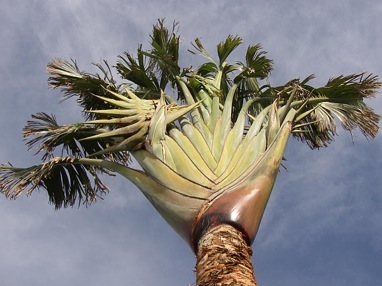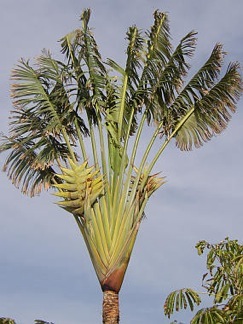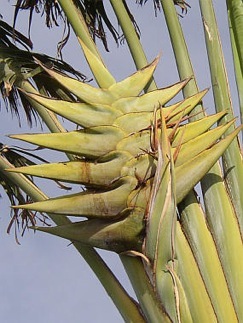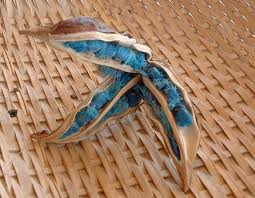
Traveler’s Plam is related to the banana and Bird of Paradise
Ravenala madagascariensis: Palm, NOT!
The Traveler’s Palm is reportedly known for providing wayfarers water, but it also has some food to offer as well.

Traveler Palms are tall-growing.
Related to the bananas and the Bird of Paradise, the Traveler’s Palm does indeed capture water at the base of its fan-like leaves, up to a quart per leaf. But it is usually buggy and or fermented from various debris caught there. A thirsty traveler would have to be desperate and hopefully have something available to strain the water with.
A better source of liquid is the sap, which can be tapped from the base of leaf stalks. It can also be boiled down to a syrup. Young leaves of the palm are edible cooked, but bitter. The starchy young fruit is edible as well. Its other claim to edible fame is the fuzzy metallic blue aril on the seeds are edible though tasteless. The mealy oily seeds are also edible.

The distinct blossoms are easy to find.
However, the oil content of the seeds and arils is 4% and 68%, respectively. The oils in composition is intermediate between palm oil and cocoa butter (oleic acid 39% and palmitic acid 34–42%.) As oil is very important and one of the more difficult foraging needs to meet.
One odd aspect about the palm from Madagascar is that it is the only species in its genus, Ravenala madagascariensis, like the Nandina and Florida Pennyroyal which is Piloblephis rigida. Ravenala is what the Madagascarians call the plant.
Green Deane’s “Itemized” Plant Profile
IDENTIFICATION: A large and erect palm-like plant that can grow to 75 feet tall and two feet through. It’s crown looks like a gigantic flat fan comprised of many 10-foot long banana-like leaves. Its large green fan-shaped flower are borne in cluster and can be to three feet long. Leaf stalks have been used to make paper.
TIME OF YEAR: Year round.
ENVIRONMENT: Very adaptable but will not tolerate any salt conditions. Partial shade, or full sun.
METHOD OF PREPARATION: Seeds and arils raw or cooked, young leaves cooked, young fruit cook (but they get woody quickly.) Sap can be made in to syrup or sugar.


